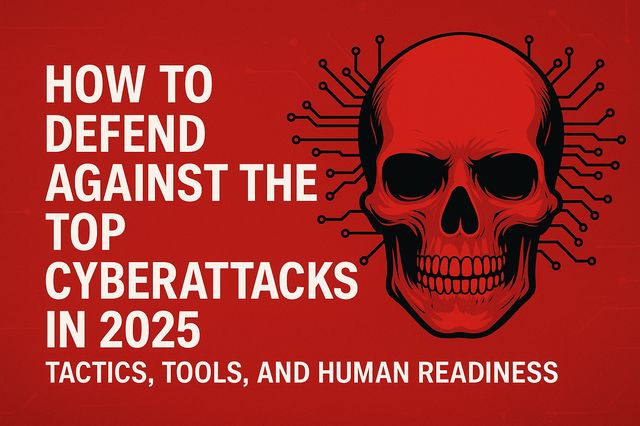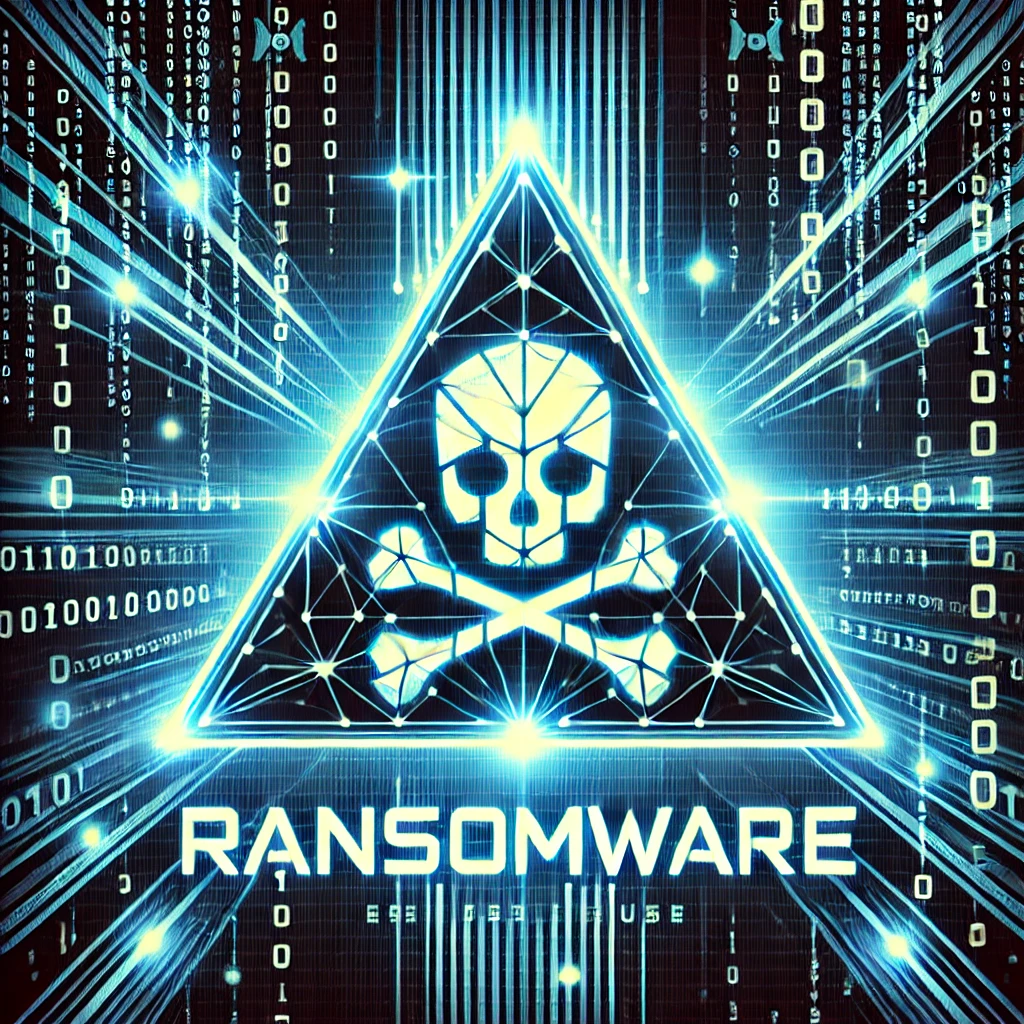In 2025, cyberattacks are faster, smarter, and more adaptive than ever. From AI-driven phishing to zero-day exploits, attackers exploit both human behavior and technical blind spots. This guide reveals how modern CISOs can prepare, respond, and build resilient infrastructure against today’s most common threats.
While this guide focuses on understanding and defending against the most common cyberattacks, a complementary resource explores how cloud, AI, and decentralization reshape the cybersecurity foundations organizations rely on.
Read our full strategic guide: Cybersecurity Foundations 2025 | Essential Concepts & Technologies

Practical defense strategies for CISOs, IT leaders, and security teams to anticipate and counter modern attack techniques
The cybersecurity battlefield has changed. Automation, cloud adoption, and AI have blurred the lines between prevention and exposure. Traditional firewalls and antivirus tools can no longer keep pace with attacks that evolve in seconds and target users instead of systems.
For security executives, the challenge isn’t just to stop attacks it’s to understand how they work, what they exploit, and which defenses can truly stop them.
This article breaks down the most critical attack types of 2025, explains how each operates, and outlines the human, procedural, and technological measures every CISO must enforce to build lasting resilience.
Phishing Attacks | The Psychology of Trust Exploited
Phishing attacks remain the number one entry point for breaches in 2025. By imitating trusted senders and exploiting human emotion, attackers gain credentials, deploy malware, or infiltrate cloud systems. Effective defense combines Zero Trust, AI-driven detection, and continuous employee awareness.

Phishing is not just an old tactic it’s the most adaptive and profitable form of cybercrime in existence. Attackers don’t break through firewalls; they walk through the front door users open for them. A convincing email, chat message, or login prompt is all it takes to turn an unsuspecting employee into a breach vector.
Modern phishing campaigns are powered by automation and artificial intelligence. Messages are personalized using harvested data from previous leaks and public profiles. Tone, language, and even signature blocks mimic corporate communication perfectly. The result: users fail to notice the difference between a genuine message and a forged one.
What makes phishing dangerous is that it preys on instinct rather than logic. Urgency (“your account will be locked”), authority (“request from the CFO”), and curiosity (“invoice attached”) trigger rapid reactions that bypass rational verification. This human reflex is exactly what attackers weaponize.
Technically, phishing succeeds because many organizations still rely on legacy email filters that can’t detect dynamic URLs, legitimate cloud storage links, or brand impersonation domains. Once credentials are harvested, attackers move laterally through VPNs, SaaS platforms, and remote-access tools often unnoticed.
To defend effectively, organizations must integrate layered, adaptive protection:
- AI-based email security and sandboxing to analyze every inbound message in real time.
- Zero Trust Access policies that re-authenticate identity for every critical action.
- MFA enforcement and conditional access to block credential replay.
- User and Entity Behavior Analytics (UEBA) to detect suspicious logins or data movement.
- Continuous awareness training simulating real attacks across departments.
Why It Matters
Phishing is no longer a rookie mistake it’s an enterprise-level weapon. Every CISO should treat phishing as an identity-attack problem, not an email-filtering issue. Defense now means combining machine learning, human awareness, and architectural Zero Trust.
FAQ Phishing Attacks
AI-driven phishing can generate realistic messages in seconds, adapting language, branding, and timing to each target’s behavior.
By enforcing identity-based security MFA, adaptive authentication, and real-time behavioral analytics integrated with SIEM and XDR.
They rely on static rules and signature lists, while modern phishing uses cloud-hosted links, dynamic redirects, and legitimate platforms to appear safe.
Disconnect the endpoint, reset credentials, investigate via XDR logs, and isolate any connected accounts to prevent lateral spread.
Through continuous, scenario-based training, executive-level phishing simulations, and rewarding correct reporting to reinforce secure habits.
Man-in-the-Middle (MitM) Attacks | Intercepting Trust in Transit
A Man-in-the-Middle (MitM) attack happens when an attacker secretly intercepts or modifies communication between two parties. By exploiting insecure networks (Read More), outdated encryption, or weak authentication, the attacker can steal credentials, manipulate data, or hijack active sessions.

MitM attacks target the invisible layer of communication that organizations often take for granted the trust between systems. When a user connects to a network, especially public Wi-Fi or poorly configured enterprise access points, an attacker can silently position themselves between the device and the destination server. From that point forward, every bit of data exchanged logins, emails, transactions passes through the attacker’s hands.
The attack thrives on weak encryption and poor certificate validation. Outdated SSL/TLS protocols, unverified digital certificates, or misconfigured DNS records allow attackers to impersonate legitimate services. Even encrypted sessions can be compromised if the attacker injects themselves before encryption is established.
Human behavior plays a central role. Employees often connect to hotel, airport, or café Wi-Fi networks without VPNs, reuse passwords, or dismiss browser warnings about insecure connections. These small moments of convenience create the perfect environment for interception. Attackers rely on this human tendency the assumption that “it will be fine just this once.”
Technically, MitM attacks exploit the lack of network verification and endpoint visibility. Legacy security tools focus on perimeter defense but fail to inspect encrypted traffic or detect session hijacking. In hybrid and remote environments, this gap widens especially when unmanaged devices access sensitive resources.
To defend effectively, CISOs must assume that every connection is untrusted until verified.
- Enforce end-to-end encryption (TLS 1.3 or higher) across all services and applications.
- Use VPNs, ZTNA, or SASE frameworks to secure remote access and network edges.
- Implement DNSSEC, certificate pinning, and strict SSL validation to prevent impersonation.
- Monitor traffic anomalies using NDR/XDR systems that detect suspicious packet patterns.
- Educate employees to avoid unsecured networks and verify certificate warnings.
Why It Matters
MitM attacks compromise the very foundation of digital trust. Once communication integrity is broken, data authenticity and confidentiality collapse. For modern enterprises, securing data in transit is not a best practice it’s a strategic necessity for protecting identity, communication, and business continuity.
FAQ Man-in-the-Middle (MitM) Attacks
To intercept, read, or alter communication between two systems without either side knowing.
Through rogue Wi-Fi networks, ARP poisoning, DNS spoofing, or compromised routers that redirect traffic.
Encryption helps, but without certificate validation and proper key exchange, attackers can still intercept or forge encrypted sessions.
Connecting to unsecured networks, ignoring SSL warnings, or using public Wi-Fi without VPN protection.
By monitoring network anomalies, unusual certificate activity, and packet manipulation through SIEM, NDR, or XDR tools.
SQL Injection | Exploiting the Database from Within
SQL Injection is a code-injection attack that allows attackers to manipulate backend databases by inserting malicious SQL commands into input fields. When applications fail to properly validate user input, attackers can access, alter, or delete critical data and even gain full administrative control.

SQL Injection remains one of the most damaging and widely exploited web vulnerabilities because it targets the very heart of an organization’s data the database. Rather than breaking through external defenses, attackers exploit weak or missing input validation inside web applications. A single vulnerable field in a login form or search box can become a gateway to an entire database.During an attack, malicious code is injected into user input that’s executed by the database as part of a legitimate query. If input isn’t sanitized or parameterized, the database interprets the injected commands as trusted instructions. This allows attackers to dump sensitive data, modify records, or create new administrative users without authentication.
The persistence of SQL Injection stems from both human and technical shortcomings. Developers under pressure often skip secure coding practices, reuse old code, or fail to test edge cases. Legacy applications built before modern frameworks remain especially vulnerable, as they lack parameterized queries and centralized validation. Even well-structured environments can be compromised by a single overlooked endpoint or unprotected API.
Defending against SQL Injection requires a culture of secure development and layered protection.
- Validate and sanitize all user inputs at both client and server levels.
- Use parameterized queries or ORM frameworks instead of dynamic SQL concatenation.
- Apply least-privilege access to database accounts and segregate production environments.
- Deploy Web Application Firewalls (WAF) to detect and block malicious queries.
- Continuously test and audit code with automated vulnerability scanners and manual reviews.
Why It Matters
SQL Injection is more than a coding error it’s a systemic failure in data security governance. In 2025, as SMBs rely increasingly on online services and connected databases, one vulnerable input field can compromise customer trust, regulatory compliance, and the company’s entire digital backbone.
FAQ SQL Injection
Attackers inject malicious SQL code into application inputs that the backend database executes without proper validation.
Sensitive business data such as customer information, credentials, financial records, and internal configurations.
Because legacy applications and poor coding practices persist, and many organizations neglect secure development training.
By enforcing parameterized queries, strict input validation, and continuous code auditing combined with WAF protection.
Unusual database errors, slow response times, or irregular query logs visible in SIEM or database monitoring tools.
Brute Force Attacks | Breaking In by Persistence
A Brute Force attack is a trial-and-error method used to crack passwords, encryption keys, or login credentials by systematically testing every possible combination. Attackers exploit weak passwords, reused credentials, and unsecured authentication systems to gain unauthorized access to corporate accounts.
Brute Force attacks are among the simplest yet most effective cyber intrusion methods. Instead of exploiting software vulnerabilities, attackers rely on automation, computing power, and human negligence. By using bots and password lists harvested from previous breaches, attackers can guess credentials at scale until one works and one is all they need.
The attack succeeds because users continue to rely on weak or recycled passwords. Even when organizations enforce password policies, employees tend to make small, predictable variations. Combined with unsecured authentication endpoints, exposed remote desktop (RDP) ports, or cloud services without rate-limiting, brute-force attempts often go undetected until after a compromise.
In modern environments, attackers no longer need to target single systems. Distributed botnets can perform billions of login attempts across multiple services simultaneously. Credential stuffing a variation of brute force uses real, previously leaked credentials to bypass authentication entirely, making detection even harder.
From a human perspective, password fatigue and convenience are the root causes. Users choose easy-to-remember credentials or reuse them across platforms, believing that “no one would target me.” For attackers, that mindset is exactly the opportunity they need.
Effective defense requires both technology and behavior change.
- Implement Multi-Factor Authentication (MFA) for all critical systems and accounts.
- Set rate-limiting and account lockout policies to block repeated login attempts.
- Use password managers to encourage strong, unique passwords.
- Deploy intrusion detection and SIEM monitoring to detect abnormal login activity.
- Educate employees about credential hygiene and the risks of password reuse.
Why It Matters
Brute Force attacks may seem primitive, but automation has made them faster, smarter, and relentless. For SMBs and enterprises alike, one weak password can open the door to ransomware, data theft, or full domain
FAQ Brute Force Attacks
Attackers use automated tools to try millions of password combinations until they find one that grants access.
Brute Force guesses passwords randomly, while Credential Stuffing uses real credentials stolen from previous breaches.
Because weak passwords, lack of MFA, and exposed login endpoints remain common across many environments.
Through login anomaly monitoring, failed authentication alerts, and rate-based detection via SIEM or XDR platforms.
Combine MFA, strong password policies, rate-limiting, and user education to make automated guessing practically useless.
Credential Stuffing | Exploiting the Reuse Habit

Credential stuffing is a cyberattack that uses stolen username and password combinations from previous breaches to gain unauthorized access to other accounts. Attackers exploit password reuse across platforms, automating login attempts until they find valid credentials that still work.
Credential stuffing is one of the most common and underestimated threats facing organizations today. Instead of guessing passwords, attackers simply reuse those that have already been leaked in past data breaches. Using automated tools and massive credential databases, they test millions of login combinations across websites, VPNs, and cloud platforms until they find a match.
This attack works because people reuse the same or slightly modified passwords across multiple accounts. Even with password policies in place, the human tendency toward convenience overrides best practices. Once a valid credential pair is found, attackers can log in as legitimate users bypassing detection, MFA prompts (if poorly implemented), and even corporate VPNs.
Credential stuffing is often the first step in larger attacks such as business email compromise (BEC) or ransomware deployment. Compromised accounts are used to spread phishing campaigns internally, escalate privileges, or exfiltrate sensitive data through legitimate access channels. Since no malware is involved, traditional antivirus and endpoint tools fail to detect it.
The technological weakness lies in unmonitored authentication systems and poor visibility across login attempts. Many organizations still lack proper rate-limiting, IP reputation checks, or behavioral analytics. Without centralized identity protection, multiple failed attempts from distributed IPs often go unnoticed.
To defend effectively, organizations must integrate identity-focused protection layers and enforce credential hygiene.
- Deploy identity protection solutions (IAM, Entra ID Protection, or Okta Threat Insights) to detect reused credentials and anomalous logins.
- Implement Multi-Factor Authentication (MFA) with device or biometric verification.
- Use password breach detection tools to identify compromised credentials.
- Apply rate-limiting and geo-restriction policies to slow down automated login attempts.
- Conduct regular employee awareness sessions on password reuse and credential management.
Why It Matters
Credential stuffing doesn’t exploit software it exploits human behavior. In 2025, as billions of credentials circulate on the dark web, reusing even one password can lead to a full organizational compromise. Protecting identities is no longer optional; it’s the cornerstone of modern cyber resilience.
FAQ Credential Stuffing
Brute force relies on guessing passwords, while credential stuffing uses real credentials stolen from previous breaches.
They collect them from public breach dumps, underground marketplaces, or through phishing campaigns.
Because attackers log in using valid usernames and passwords, making their activity appear legitimate.
Strong MFA enforcement, breach monitoring, password managers, and behavioral analytics for login patterns.
By using unique passwords for every account and enabling MFA wherever possible.
join the SECITHUB community on LinkedIn or Reddit.
Zero-Day Exploits | Attacks Before Awareness
A Zero-Day exploit targets a software vulnerability that is unknown to the vendor or security community. Attackers exploit it before a patch or defense exists, often using the flaw to gain remote access, escalate privileges, or deploy stealth malware across networks.

Zero-Day exploits represent the most dangerous category of cyberattacks those that strike before defenders even know a vulnerability exists. The term “zero-day” refers to the number of days the software vendor has had to fix the flaw: zero. Attackers move fast, often discovering and weaponizing these vulnerabilities before disclosure or patch release.
The power of a Zero-Day lies in surprise and timing. Once the flaw is identified, threat actors develop custom payloads that bypass antivirus signatures and intrusion detection systems. Since no existing defense recognizes the exploit’s behavior, attacks often succeed silently, granting attackers long-term persistence or complete control of critical systems.
These exploits are typically used in targeted campaigns against high-value environments government, financial, and infrastructure networks but have become increasingly common against SMBs as part of automated scanning tools. When successful, Zero-Days can compromise cloud applications, browsers, or even firmware, leading to massive data theft or system manipulation.
From the human perspective, the real risk stems from slow response and poor patch management. Even after a vulnerability is disclosed, many organizations delay updates due to operational impact or lack of visibility. Attackers exploit this delay window, transforming Zero-Days into “N-Days” known vulnerabilities that remain open for weeks or months.
To defend against Zero-Day exploits, CISOs must build resilience rather than rely on signature-based protection.
- Implement Endpoint Detection and Response (EDR/XDR) solutions capable of detecting abnormal behavior, not just known threats.
- Use Threat Intelligence feeds to identify new indicators of compromise as soon as they appear in the wild.
- Enforce strict patch management policies with automated update cycles for OS, browsers, and third-party software.
- Isolate critical workloads through segmentation and privilege separation.
- Conduct continuous vulnerability scanning and penetration testing to identify unknown weaknesses.
Why It Matters
Zero-Day exploits expose the limits of traditional security. No organization can prevent every unknown flaw but those with layered visibility, adaptive response, and disciplined patching turn the element of surprise back on the attacker. In cybersecurity, awareness delayed is compromise guaranteed.
FAQ Zero-Day Exploits
It targets an unknown vulnerability for which no patch or defense mechanism yet exists, making it nearly impossible to detect initially.
Through reverse engineering, bug hunting, or scanning for coding flaws in widely used applications, browsers, and firmware.
Traditional tools often fail, but behavioral and AI-driven detection can identify abnormal system activity linked to exploitation.
Immediately apply vendor patches, isolate affected systems, and monitor for residual compromise indicators.
By maintaining threat intelligence integration, enforcing rapid patch cycles, and investing in continuous detection and response capabilities.
Distributed Denial of Service (DDoS) | Overwhelming the System
A Distributed Denial of Service (DDoS) attack floods a target system, website, or network with massive amounts of traffic from multiple compromised devices. The goal is to exhaust resources, disrupt operations, and make legitimate services unavailable to users.

DDoS attacks are among the most disruptive and visible forms of cyber warfare. Rather than infiltrating systems, attackers aim to overwhelm them. By controlling large botnets networks of infected computers, IoT devices, or servers they direct enormous traffic toward a target, saturating bandwidth and exhausting computing power. In extreme cases, even robust cloud infrastructures struggle to maintain uptime.
The modern DDoS landscape has evolved dramatically. Attackers now use multi-vector techniques that combine volumetric floods, protocol manipulation, and application-layer targeting. Some campaigns leverage amplification methods, such as DNS or NTP reflection, to multiply attack traffic many times over. What once required thousands of devices can now be executed by smaller, smarter botnets powered by automation and cloud abuse.
The human factor behind DDoS risk often comes from unpreparedness. Many organizations underestimate their exposure until an attack occurs, assuming that cloud hosting alone ensures resilience. Without preconfigured mitigation or incident response procedures, downtime quickly escalates from minutes to hours translating directly into financial and reputational loss.
Technically, weak network segmentation, open ports, and unprotected APIs make perfect DDoS targets. Attackers exploit these openings to generate disproportionate resource consumption or crash services entirely. In hybrid infrastructures, inconsistent firewall rules or missing rate-limiting amplify the impact.
To defend effectively, CISOs must adopt proactive, layered defense strategies.
- Use cloud-based DDoS mitigation services that can absorb and filter massive traffic surges before they hit your network.
- Deploy Web Application Firewalls (WAF) to detect and block application-layer floods.
- Implement network rate-limiting, load balancing, and redundant paths to maintain service availability.
- Monitor in real time with SIEM and NDR systems to identify traffic anomalies early.
- Establish an incident response plan that includes predefined failover procedures and communication protocols.
Why It Matters
DDoS attacks may not steal data, but they destroy trust, uptime, and customer confidence. For digital businesses, every minute offline equals lost revenue and credibility. In 2025, availability is security resilience against overloads is as critical as protection from breaches.
FAQ Distributed Denial of Service (DDoS)
A DDoS uses multiple compromised devices to generate traffic from many sources, making it far harder to block than a single-source DoS.
Volumetric floods, protocol-based attacks, and application-layer (L7) assaults that target web servers directly.
Cloud providers can absorb large traffic volumes and filter malicious packets through distributed global infrastructure.
Sudden traffic spikes, latency, partial service outages, and unexplained bandwidth saturation across multiple endpoints.
Combine proactive monitoring, rate-limiting, and cloud-based scrubbing services to ensure continuous availability under attack.
Insider Threats | The Enemy Within
An insider threat occurs when a current or former employee, contractor, or trusted partner intentionally or accidentally compromises an organization’s security. These threats exploit privileged access, human error, or negligence to steal data, disrupt operations, or aid external attackers.

Unlike most cyberattacks, insider threats come from within the organization’s own perimeter. The individual already has legitimate access to systems, data, or credentials meaning traditional defenses such as firewalls or endpoint detection are largely ineffective. The risk can be intentional, as in data theft or sabotage, or unintentional, through careless handling of sensitive information.
Intentional insider attacks are often financially motivated or tied to espionage. A disgruntled employee, a contractor with short-term access, or a partner with excessive privileges can extract trade secrets, customer data, or credentials over time. Unintentional incidents, on the other hand, stem from human error clicking malicious links, misconfiguring cloud storage, or sharing data on unsecured channels.
Technically, insider threats exploit poor access control, lack of monitoring, and inadequate segmentation. Many organizations fail to implement the “least privilege” principle, giving users more access than they require. In hybrid and remote environments, this risk multiplies when employees use personal devices or unsanctioned apps to handle corporate data.
From a behavioral standpoint, signs of insider threats often go unnoticed. Unusual file transfers, after-hours access, or data downloads from atypical locations may signal misuse. However, without User and Entity Behavior Analytics (UEBA) or continuous auditing, these activities blend into normal operations.
To mitigate insider threats, organizations must blend policy, technology, and culture.
- Apply least-privilege access and review permissions regularly.
- Deploy UEBA and DLP solutions to monitor sensitive data movement.
- Implement strict offboarding processes that revoke access immediately upon termination.
- Encourage a transparent culture where employees report suspicious activity without fear.
- Educate staff on secure data handling and social engineering awareness.
Why It Matters
Insider threats undermine the foundation of organizational trust. Unlike external attacks, they are invisible until damage is done. By combining behavioral analytics, disciplined access control, and a culture of accountability, organizations can protect themselves from the most unpredictable threat the trusted human.
FAQ Insider Threats
Malicious insiders (intentional harm), negligent insiders (careless mistakes), and compromised insiders (accounts hijacked by outsiders).
Because insiders use legitimate credentials and approved access paths, blending in with normal activity.
UEBA solutions identify deviations from baseline user behavior, alerting security teams to potential misuse.
Enforcing least-privilege access, regular audits, offboarding controls, and continuous employee awareness programs.
Isolate affected systems, suspend credentials, conduct a forensic review, and involve HR and legal teams in coordinated response.
Advanced Persistent Threats (APTs) | Silent Infiltration Over Time
An Advanced Persistent Threat (APT) is a long-term, targeted cyberattack where threat actors infiltrate a network and remain undetected for extended periods. Their goal is to steal sensitive data, disrupt operations, or conduct espionage without triggering immediate alarms.
APTs represent the most sophisticated and resourceful form of cyberattack. Unlike quick, opportunistic hacks, these operations are carefully planned and executed over months or even years. Attackers establish a foothold inside the network, move laterally, and exfiltrate data in small, undetectable increments often without ever being discovered.
Typically carried out by organized crime groups or state-sponsored actors, APTs target critical industries such as defense, finance, healthcare, and technology. They exploit a combination of zero-day vulnerabilities, social engineering, and credential theft to gain initial access. Once inside, attackers install backdoors, disguise their presence with legitimate processes, and maintain command-and-control connections that blend with normal traffic.
The persistence of APTs relies on stealth and patience. Rather than causing immediate damage, attackers observe internal systems, map network architecture, and study user behavior to avoid detection. Over time, this allows them to extract valuable data, manipulate business processes, or prepare for strategic sabotage.
Human error amplifies APT risks. Employees may unknowingly open malicious attachments, grant access to third parties, or fail to report subtle system anomalies. Weak monitoring, lack of segmentation, and slow incident response further extend the attacker’s window of opportunity.
Defending against APTs requires proactive, intelligence-driven security rather than reactive patching.
- Deploy Endpoint Detection and Response (EDR/XDR) solutions capable of identifying anomalous behavior and lateral movement.
- Implement network segmentation to limit access between sensitive systems.
- Use threat intelligence integration to track emerging attacker techniques (TTPs).
- Conduct continuous threat hunting and forensic log analysis to identify hidden compromise indicators.
- Train employees and executives to recognize social engineering and privilege escalation attempts.
Why It Matters
APTs redefine cybersecurity from a sprint to a marathon. They prove that even well-defended organizations can be infiltrated if attackers are patient enough. Continuous visibility, intelligence sharing, and rapid response aren’t optional — they are the only way to outlast adversaries who never stop watching.
FAQ Advanced Persistent Threats (APTs)
APTs are long-term, targeted campaigns designed to remain undetected, focusing on data theft and espionage rather than immediate disruption.
State-sponsored groups, organized crime syndicates, or highly skilled hackers with access to advanced resources and tools.
By installing hidden backdoors, using legitimate credentials, and blending their traffic into normal network activity.
Unusual outbound traffic, new administrator accounts, and unexplained data exfiltration from critical systems.
Combine continuous monitoring, segmentation, threat intelligence, and rapid incident response to detect and disrupt long-term infiltration.
Cross-Site Scripting (XSS) | Injecting Malicious Code into Trust
Cross-Site Scripting (XSS) is a web application vulnerability that allows attackers to inject malicious scripts into trusted websites. When users visit the compromised page, their browsers execute the attacker’s code, enabling data theft, session hijacking, or credential compromise.
Cross-Site Scripting attacks target the point of trust between a website and its users. Instead of breaking into servers (Read More) , attackers manipulate the client-side browser environment. When a vulnerable web application fails to properly sanitize user input, injected scripts execute directly in the victim’s browser as if they originated from the trusted site itself.
There are three main types of XSS: stored, reflected, and DOM-based. Stored XSS involves permanently embedding malicious code into a database or comment field that reappears each time the page loads. Reflected XSS occurs when malicious code is sent via a crafted URL or form and executed immediately upon clicking. DOM-based XSS manipulates the website’s client-side scripts to modify how the page behaves for each visitor.
The danger of XSS lies in how seamlessly it hijacks trust. Once executed, the injected script can steal session cookies, capture keystrokes, redirect users to phishing sites, or perform actions on behalf of the logged-in user. Attackers can impersonate victims, change account settings, or pivot deeper into corporate systems connected to the web application.
From a technical standpoint, XSS thrives where web applications dynamically display user input without proper encoding or validation. Complex JavaScript frameworks, poorly configured content security policies (CSP), and legacy code amplify the risk. The human factor adds another layer developers unaware of secure coding practices often underestimate how easily browsers can be manipulated.
To defend against XSS, organizations must enforce secure coding and browser-level protection.
- Sanitize and encode all user input before rendering it on web pages.
- Implement strong Content Security Policies (CSP) to limit script execution sources.
- Use frameworks that automatically escape dynamic content to prevent injection.
- Perform regular web vulnerability scans with automated and manual testing.
- Educate developers about client-side attack surfaces and secure design principles.
Why It Matters
XSS attacks exploit the invisible bridge between user trust and application behavior. For modern businesses that rely on web applications, one unchecked input field can turn a trusted website into a weapon against its users. Securing client-side interactions is essential to maintaining credibility and compliance in a digital-first world.
FAQ Cross-Site Scripting (XSS)
Improper input validation and lack of output encoding when displaying user-generated content on web pages.
Injected scripts can access session cookies, input fields, or local storage, sending sensitive data to the attacker’s server.
Stored XSS persists in the application, reflected occurs in real time via crafted URLs, and DOM-based manipulates client-side scripts.
By sanitizing input, encoding output, enforcing Content Security Policies (CSP), and using secure frameworks.
Web vulnerability scanners, browser developer tools, and manual penetration testing using frameworks like OWASP ZAP or Burp Suite.
join the SECITHUB community on LinkedIn or Reddit.
Drive-By Download | Infection Without Interaction
A Drive-By Download attack silently installs malware on a user’s device when they visit a compromised or malicious website. The infection requires no user interaction simply viewing the page triggers hidden scripts that exploit browser or plugin vulnerabilities.
Drive-By Download attacks redefine the meaning of “unintentional compromise.” Unlike phishing or social engineering, these attacks don’t rely on deception but on invisible execution. When a user visits a malicious or infected website, embedded scripts automatically download and execute malware in the background, exploiting unpatched browser flaws, plugins, or outdated operating systems.
The attacker’s objective is stealth. Instead of obvious payloads, Drive-By campaigns often deliver lightweight droppers small programs that silently install spyware, ransomware, or remote-access trojans (RATs). These infections frequently spread through compromised advertising networks (“malvertising”) or legitimate websites injected with malicious iframes and JavaScript code.
The success of a Drive-By attack depends on two key weaknesses: outdated software and poor endpoint security. Many users postpone browser or OS updates, leaving them exposed to known exploits. Legacy plug-ins like Flash, Java, or ActiveX have become primary entry points, and even modern browsers can be vulnerable when security patches are delayed.
Human behavior plays a role too users tend to browse freely, assuming that trusted sites are safe. Attackers exploit this misplaced trust by compromising high-traffic domains or embedding malicious ads in legitimate networks. The infection happens instantly, often before a page fully loads.
To prevent Drive-By infections, organizations must combine proactive patching with multi-layered endpoint protection.
- Keep browsers, operating systems, and plug-ins fully updated with automated patch management.
- Deploy next-generation antivirus or EDR/XDR tools that block script-based and behavioral anomalies.
- Use web filtering and DNS protection (Read More) to block access to malicious or suspicious domains.
- Harden browsers by disabling unnecessary plug-ins and enforcing least-privilege execution.
- Educate users about the risks of outdated software and suspicious website behavior.
Why It Matters
Drive-By Download attacks require no clicks, no attachments, and no awareness. That’s what makes them so dangerous. In a hyper-connected digital world, passive browsing can become an active compromise. The only true defense is continuous patching, behavioral monitoring, and zero-trust web access.
FAQ Drive-By Download
Malicious code hidden in a website exploits browser or plug-in vulnerabilities to install malware without user interaction.
Spyware, ransomware, credential stealers, and remote-access trojans (RATs) are frequent payloads.
Through compromised legitimate websites, infected advertising networks, or malicious redirects hidden in JavaScript code.
By keeping systems patched, enforcing browser hardening, and using DNS/web filtering and EDR/XDR solutions.
Unexplained system slowdowns, new background processes, browser crashes, or outbound network activity to unknown domains.
Session Hijacking | Stealing Online Identities Midstream
Session hijacking occurs when an attacker intercepts or steals a valid session token to impersonate a legitimate user. By exploiting weak session management, unencrypted communication, or cross-site scripting, attackers gain access to accounts without needing credentials.
Session hijacking targets the digital handshake that authenticates users after login. When a session token is created usually through cookies or authentication headers it grants temporary trust between the client and the server. If an attacker intercepts, predicts, or steals that token, they can bypass authentication entirely and act as the victim in real time.
There are several common types of session hijacking. Network-based hijacking uses packet sniffing to capture unencrypted session cookies. Cross-site scripting (XSS) or malicious browser extensions can extract tokens directly from the browser. Session fixation tricks users into logging in with a token controlled by the attacker. Once compromised, the attacker can view sensitive data, change account settings, or escalate privileges within corporate systems.
The success of session hijacking depends largely on poor encryption and weak session management. HTTP sessions that aren’t properly invalidated, cookies transmitted without the “Secure” or “HttpOnly” flags, or reused session IDs all create opportunities for exploitation. In hybrid and SaaS environments, shared tokens across apps amplify the risk — a single hijacked session can compromise multiple connected services.
Human behavior also plays a major role. Users frequently stay logged in for convenience, connect over public Wi-Fi without VPNs, or ignore warnings about invalid certificates. These actions make session interception far easier for attackers equipped with sniffing tools or rogue access points.
To defend effectively, organizations must combine technical controls with secure identity hygiene.
- Use HTTPS exclusively and enforce TLS 1.3 encryption for all communications.
- Regenerate session IDs after login and invalidate tokens immediately upon logout.
- Set Secure and HttpOnly flags on cookies to prevent client-side access.
- Deploy MFA and adaptive authentication to verify identity during sensitive actions.
- Monitor for anomalous session activity via XDR or behavioral analytics.
Why It Matters
Session hijacking transforms trust into a weapon. When attackers hijack authenticated sessions, they bypass every traditional defense layer. In a world of continuous connectivity, session security is the new perimeter — and its strength determines the integrity of every digital interaction.
FAQ Session Hijacking
Attackers steal or intercept active session tokens to impersonate legitimate users and gain unauthorized access.
Packet sniffing, cross-site scripting, malicious extensions, or forcing users to log in through attacker-controlled tokens.
They store session identifiers — if compromised, they allow attackers to bypass authentication entirely.
Use HTTPS, regenerate session IDs after login, apply Secure/HttpOnly flags, and implement adaptive MFA.
Concurrent logins from different locations, rapid privilege escalation, or activity inconsistent with the user’s behavior profile.
join the SECITHUB community on LinkedIn or Reddit.
Social Engineering | Manipulating the Human Firewall
Social engineering is a psychological manipulation technique that tricks individuals into revealing confidential information or performing unsafe actions. Instead of exploiting software vulnerabilities, attackers exploit human behavior using trust, authority, and urgency to bypass security controls.

Social engineering is not a technical attack it’s a human one. It targets the most unpredictable component in cybersecurity: people. By understanding psychology better than technology, attackers convince victims to hand over access, credentials, or sensitive data willingly. The manipulation can happen through emails, phone calls, social media, or even face-to-face interactions.
Common social engineering techniques include phishing, pretexting, baiting, tailgating, and vishing (voice phishing). In each case, the attacker constructs a believable scenario — a fake executive request, an urgent IT notice, or a delivery confirmation to create pressure and prompt immediate action. The goal is to bypass logical defenses by triggering emotional responses such as fear, curiosity, or compliance.
The success of social engineering depends on both human and organizational weaknesses. Overworked employees, unclear procedures, and lack of awareness create fertile ground for manipulation. Attackers often gather intelligence through public sources (LinkedIn, company websites, or social media) to craft hyper-targeted messages that appear legitimate.
From a technical standpoint, there is little that firewalls or antivirus tools can do against persuasion. Security must therefore extend to culture, policy, and continuous training. Every employee from helpdesk to CEO must be able to recognize manipulation patterns and know how to respond safely.
To defend effectively, organizations must blend human education with detection systems.
- Implement continuous awareness and simulation programs that test real-world social engineering scenarios.
- Use strict verification procedures for sensitive actions such as wire transfers or access approvals.
- Establish clear reporting channels for suspicious communications or interactions.
- Limit public exposure of internal data on websites and social networks.
- Integrate behavioral analytics and insider threat monitoring to detect abnormal requests or communications.
Why It Matters
Technology can secure networks — but only awareness can secure people. Social engineering remains the starting point for most breaches, from phishing to ransomware. In 2025, organizations that fail to train their human firewall risk turning every employee into an open door for attackers.
FAQ Social Engineering
It exploits human emotions like fear, urgency, and trust bypassing logic and technical controls entirely.
Phishing emails, fake support calls (vishing), impersonation, tailgating into secure areas, and baiting with infected devices.
Because they target human judgment, not software vulnerabilities prevention depends on awareness, not firewalls.
Through regular awareness training, multi-step verification for critical actions, and fostering a culture of skepticism.
Do not engage, verify independently through known channels, and report the incident to security teams immediately.
Malicious Browser Extensions | The Invisible Backdoor
Featured Snippet
Malicious browser extensions disguise themselves as legitimate add-ons while secretly collecting data, injecting ads, or hijacking sessions. By exploiting browser permissions and user trust, attackers gain persistent access to sensitive information without triggering traditional security alerts.
Malicious browser extensions represent one of the most underestimated attack surfaces in modern cybersecurity. Installed directly into users’ browsers, they operate inside the trusted environment of Chrome, Edge, or Firefox effectively bypassing most endpoint and network defenses. Once granted excessive permissions, these extensions can read browsing history, capture credentials, or inject malicious scripts into legitimate web sessions.
Attackers use several distribution channels to spread these backdoors. Some upload extensions to official stores with hidden malicious code that activates only after installation. Others compromise legitimate extensions through supply chain attacks (Read More) or buy expired add-ons from developers, updating them later with harmful functionality. Users, unaware of the risk, often install them to improve productivity or convenience unknowingly granting full access to their digital life.
The danger lies in the level of access browsers grant extensions. With permissions to read and modify every web page, an extension can silently monitor activity, steal authentication cookies, or redirect traffic to phishing sites. In enterprise environments, a single infected browser can leak cloud credentials, API keys, and session tokens effectively bypassing Zero Trust architectures.
Human behavior compounds the problem. Employees rarely question browser prompts requesting access to “read and change all data on websites you visit.” Even cautious users trust brand names and positive ratings in extension stores, assuming these indicate safety. Attackers exploit that assumption, turning convenience into compromise.
To mitigate this growing threat, organizations must treat browsers as critical security endpoints.
- Whitelist approved browser extensions and block all others through centralized policies.
- Use enterprise browser management tools to enforce permissions and monitor usage.
- Educate users about extension risks and encourage installations only from vetted sources.
- Deploy endpoint protection (EDR/XDR) to detect data exfiltration or suspicious browser behavior.
- Regularly audit installed extensions and remove those no longer required or maintained.
Why It Matters
Malicious extensions bypass the perimeter and live where users work inside the browser. As cloud adoption grows (Read More) , browsers have effectively become the new operating system of business. Securing them is no longer optional; it’s an essential layer of modern enterprise defense.
FAQ Malicious Browser Extensions
Through official extension stores, phishing campaigns, or compromised legitimate add-ons updated with malicious code.
Browsing history, credentials, session cookies, clipboard data, and sensitive information entered on web forms.
Because they appear legitimate, are user-installed, and operate within a trusted environment that most tools ignore.
By enforcing strict extension whitelisting, central management, and continuous endpoint monitoring.
Unexpected redirects, injected ads, unusual pop-ups, or new permissions requested after an update.
join the SECITHUB community on LinkedIn or Reddit.
Ransomware | The Business of Extortion
Ransomware is a type of malware that encrypts files or entire systems, locking users out until a ransom is paid. Modern ransomware operations target businesses of all sizes, using double extortion tactics stealing data before encryption to pressure victims into payment.

Ransomware has evolved from simple disruption to a mature criminal business model. Attackers no longer rely on random infections they operate like professional organizations. Once they infiltrate a network, they quietly move laterally, identify valuable data, disable backups, and only then trigger encryption. The victim is left with an ultimatum: pay or lose everything.
The attack chain typically starts with phishing emails, credential theft, or exploitation of remote access tools such as RDP or VPN gateways. Once inside, attackers deploy malware that encrypts critical files with strong algorithms like AES or RSA. In modern “double extortion” campaigns, data is exfiltrated before encryption, giving attackers leverage to threaten public exposure if the ransom is not paid.
Ransomware groups increasingly adopt Ransomware-as-a-Service (RaaS) models, where developers sell or lease their malicious platforms to affiliates. This scalability has turned ransomware into a global industry worth billions, hitting enterprises, SMBs, and even public institutions. With cryptocurrencies enabling anonymous payments, attribution and prosecution remain rare.
The human factor plays a decisive role. Users who click on malicious links or download infected attachments often initiate the breach. Poor backup hygiene, delayed patching, and lack of segmentation amplify the damage. Once encryption begins, every second counts response speed determines recovery success.
To defend effectively, organizations must build prevention, detection, and recovery into one strategy.
- Implement immutable, offline backups and test recovery procedures regularly.
- Deploy EDR/XDR solutions to detect early-stage intrusion and lateral movement.
- Harden remote access tools by restricting RDP/VPN exposure and enforcing MFA.
- Patch critical vulnerabilities quickly, especially in internet-facing systems.
- Educate employees to recognize ransomware delivery methods and phishing attempts.
Why It Matters
Ransomware is no longer a malware problem it’s a business risk. For many organizations, downtime and data loss cost more than the ransom itself. True resilience requires preparation: protecting data before it’s encrypted and responding faster than the attackers can demand payment.
FAQ Ransomware
Through phishing emails, malicious attachments, credential theft, or exploitation of remote services such as RDP.
Attackers steal data before encryption and threaten to publish it if the ransom is not paid, adding pressure on victims.
Paying is discouraged; it doesn’t guarantee decryption and encourages further attacks. Focus should be on recovery and law enforcement coordination.
Maintain offline backups, segment networks, and use real-time detection tools to stop attacks before encryption spreads.
Unusual file renaming, sudden CPU spikes, disabled security tools, and unauthorized data transfers before system lockout.
Cloud Misconfiguration Attacks | Breaches by Design Flaws
Cloud misconfiguration attacks exploit incorrect security settings in cloud environments, such as open storage buckets, exposed APIs, or overly permissive access controls. These design flaws allow attackers to steal sensitive data, hijack resources, or move laterally within the cloud infrastructure.
Cloud misconfiguration has become one of the leading causes of data breaches in 2025. As organizations migrate workloads to public and hybrid clouds, security responsibilities often blur between providers and customers. A single unchecked permission, unprotected storage container, or exposed API can open a gateway for attackers to access confidential data — without exploiting any software vulnerability at all.
These attacks typically occur when teams deploy services quickly without applying proper security baselines. Common examples include publicly accessible S3 buckets, default credentials in virtual machines, or unencrypted data in transit. Attackers use automated scanners to find these misconfigurations across thousands of cloud assets, exploiting them in minutes.
The challenge lies in scale and complexity. Cloud environments change constantly, with new services, users, and integrations added daily. Without consistent governance and visibility, security gaps emerge faster than they can be fixed. Furthermore, many organizations rely on shared responsibility assumptions believing the provider protects everything, when in reality, misconfiguration risk belongs to the customer.
From a human standpoint, cloud convenience often overshadows caution. Developers prioritize speed and automation, sometimes granting broad privileges “for testing” and forgetting to remove them later. Misconfigured identity and access management (IAM) roles or unrestricted API keys can lead to full environment compromise.
To defend effectively, organizations must prioritize visibility, automation, and policy enforcement.
- Continuously audit cloud configurations with automated compliance tools (CSPM, CNAPP).
- Apply least-privilege access to IAM roles and service accounts.
- Encrypt data in transit and at rest, and disable public access to storage resources.
- Implement network segmentation and firewall rules for virtual environments.
- Educate DevOps (Read More) and IT teams on shared responsibility and secure deployment practices.
Why It Matters
Cloud misconfigurations don’t require elite hackers they only require neglect. As cloud adoption accelerates, security by design must replace security by assumption. Visibility, automation, and governance are the only ways to prevent human mistakes from becoming global headlines.
FAQ Cloud Misconfiguration Attacks
It’s an exploitation of insecure cloud settings, such as open storage, mismanaged credentials, or exposed APIs.
Because cloud environments evolve rapidly, and security settings often lag behind development speed.
They use automated scanners and bots to search for publicly exposed endpoints and unsecured containers.
Under the shared responsibility model, the customer is responsible for securing configurations and access control.
Cloud Security Posture Management (CSPM), Cloud-Native Application Protection Platforms (CNAPP), and IAM auditing tools.
Supply Chain Attacks | Compromising Through Trust
A supply chain attack targets the trusted vendors, software, or services an organization relies on. By compromising these third parties, attackers gain indirect access to internal systems and sensitive data turning trust itself into the ultimate vulnerability.

Supply chain attacks exploit the interconnected nature of modern IT ecosystems. Instead of attacking companies directly, adversaries infiltrate the software, updates, or infrastructure provided by trusted partners. When victims install or integrate the compromised components, they unknowingly invite attackers inside their environment. The infamous SolarWinds and MOVEit incidents demonstrated how a single trusted integration could compromise thousands of organizations worldwide.
These attacks are sophisticated and strategic. Threat actors inject malicious code into legitimate software updates, tamper with libraries, or compromise continuous integration pipelines (CI/CD). Once deployed, the backdoor operates under the guise of a trusted vendor’s signature, allowing attackers to exfiltrate data or conduct espionage undetected for months. In some cases, attackers exploit hardware or firmware in the supply chain, embedding persistent vulnerabilities before devices even reach customers.
The human element plays a critical role. Companies often assume vendor software is inherently secure and skip due diligence or code validation. The convenience of automated updates and cloud integrations creates blind trust, which attackers leverage to move laterally through connected environments. Each new vendor connection becomes a potential attack vector.
From a technical standpoint, lack of third-party visibility and weak identity control amplify the threat. Without continuous risk assessment and dependency monitoring, organizations cannot detect when their trusted providers become compromised.
To defend effectively, organizations must enforce visibility, validation, and control across their entire supply chain.
- Perform rigorous vendor risk assessments before onboarding any external service or software.
- Require software bills of materials (SBOMs) and digital code signing from all suppliers.
- Monitor third-party activity and apply least-privilege access to integrations and APIs.
- Use endpoint and network monitoring (XDR/NDR) to detect anomalous data flows involving external systems.
- Establish incident response procedures specifically for vendor-originated breaches.
Why It Matters
Supply chain attacks turn trust the foundation of digital collaboration into an exploitable weakness. In a world of complex integrations, your security is only as strong as your least-secure partner. Governance, validation, and transparency are no longer bureaucratic; they’re existential.
FAQ Supply Chain Attacks
Instead of targeting a company’s systems directly, attackers compromise a trusted third-party vendor to gain indirect access.
Malicious software updates, compromised open-source libraries, or tampered CI/CD pipelines used to distribute malware.
Because they abuse trust compromised updates or vendor access are typically allowed through security controls.
By enforcing vendor risk management, verifying digital signatures, and continuously monitoring supplier integrations.
Building supply chain visibility and requiring SBOM documentation to track every component in deployed software.
Password Attacks | Exploiting the Weakest Keys
Password attacks aim to crack or steal user credentials using techniques like brute force, dictionary attacks, keylogging, or credential replay. By exploiting weak, reused, or exposed passwords, attackers gain direct access to systems, networks, and sensitive data.
Password attacks remain one of the oldest and most successful methods of unauthorized access. Despite decades of awareness, weak and reused passwords continue to be the Achilles’ heel of enterprise security. Attackers no longer “guess” passwords manually; they automate the process using massive databases of stolen credentials and advanced cracking tools capable of testing billions of combinations per second.
There are several primary forms of password attacks. Brute force and dictionary attacks systematically test potential passwords until one matches. Credential replay uses leaked credentials from previous breaches. Keylogging and clipboard hijacking capture passwords as users type or copy them. In more advanced operations, attackers deploy phishing campaigns or social engineering to trick users into revealing credentials directly.
The success of these attacks stems from predictable human behavior. Employees reuse passwords across work and personal accounts, choose simple patterns, or store credentials in unsecured files. Even with password policies in place, many organizations fail to enforce multi-factor authentication (MFA) or monitor abnormal login behavior allowing attackers to exploit credentials without triggering alerts.
On the technical side, unprotected authentication endpoints, legacy systems without account lockouts, and exposed remote services (like RDP or SSH) expand the attack surface. Once a password is compromised, attackers can escalate privileges, deploy malware, or pivot across connected systems.
To mitigate password based attacks, organizations must eliminate password dependency and strengthen authentication controls.
- Enforce Multi-Factor Authentication (MFA) across all critical accounts and remote access systems.
- Use password managers to generate and store complex, unique credentials.
- Implement account lockout and throttling policies to prevent automated login attempts.
- Adopt passwordless authentication using biometrics or FIDO2 tokens where possible.
- Monitor authentication logs through SIEM or XDR to detect anomalies and repeated failures.
Why It Matters
Passwords are still the first line of defense and often the weakest. In 2025, credential-based breaches account for most initial compromises. Strengthening authentication is not a checkbox; it’s the difference between an isolated incident and a full-scale intrusion.
FAQ Password Attacks
Brute force, dictionary attacks, credential replay, keylogging, and phishing-based credential theft.
Because users continue to reuse weak passwords, and many systems still rely solely on password-based authentication.
By enforcing MFA, adopting password managers, monitoring for unusual login activity, and moving toward passwordless systems.
They generate strong, unique passwords and protect them in encrypted vaults, reducing the risk of reuse and compromise.
Through failed login monitoring, SIEM correlation rules, and real-time alerts for brute force or credential stuffing behavior.
join the SECITHUB community on LinkedIn or Reddit.
AI-Powered Cyberattacks | Automation Turned Against You
AI-powered cyberattacks leverage machine learning and automation to enhance precision, speed, and scale. Attackers use AI to craft personalized phishing, bypass defenses, and dynamically adapt their tactics making traditional detection tools increasingly ineffective.

Artificial Intelligence has revolutionized both cybersecurity defense and offense. In 2025, the same technologies that power security analytics, fraud detection, and automation are being weaponized by attackers. AI allows threat actors to analyze massive data sets, identify weak points, and execute attacks faster than human defenders can respond.These attacks manifest in several forms. AI-driven phishing uses generative models to create flawless, context-aware messages indistinguishable from legitimate communication. Malware automation enables adaptive code that rewrites itself to evade antivirus signatures. Deepfake technology allows attackers to impersonate executives in video or audio, convincing employees to transfer funds or disclose information. Even AI-powered vulnerability scanning automates reconnaissance across thousands of systems in seconds.
The strength of AI attacks (Read More) lies in adaptability. Traditional defense tools rely on known indicators or static patterns, while AI-driven threats evolve continuously. A machine-learning model can detect how a security system responds and adjust tactics in real time effectively turning every blocked attempt into new training data for the attacker.
From the human perspective, AI erodes the boundaries of trust. Employees who once relied on visual or linguistic cues to detect fraud now face messages, voices, and videos indistinguishable from reality. Attackers exploit this confusion to target both technical systems and emotional responses simultaneously.
To defend effectively, organizations must fight automation with smarter automation.
- Integrate AI-driven detection platforms (XDR, UEBA, and SOAR) capable of identifying anomalies beyond static signatures.
- Deploy content verification tools to detect deepfakes and synthetic media manipulation.
- Use AI-powered threat intelligence to predict and block attack patterns before execution.
- Continuously retrain defensive models to adapt to new attacker behaviors.
- Educate employees about deepfakes, AI-generated phishing, and synthetic identity risks.
Why It Matters
AI has transformed cybercrime into an arms race of intelligence. The organizations that survive won’t be the ones with the biggest firewalls, but those that can learn, adapt, and respond as quickly as their attackers. In 2025 and beyond, resilience is no longer manual it’s intelligent.
FAQ AI-Powered Cyberattacks
They automate phishing, exploit discovery, and malware evasion, using machine learning to adapt and personalize attacks dynamically.
They continuously learn from defensive responses and modify behavior, making traditional, signature-based detection ineffective.
By deploying adaptive, AI-driven detection and response platforms and maintaining strong human oversight.
Deepfake videos, cloned voices, and generative phishing messages that mimic real executives or partners.
Because attackers now use realistic content and voices awareness training must include deepfake and synthetic media recognition.
The landscape of cyber threats in 2025 is no longer defined by isolated incidents it’s a living ecosystem of automation, deception, and speed. Every attack covered in this guide, from phishing to AI-driven exploitation, represents a lesson in how technology and human behavior intertwine. What once required months of planning can now happen in minutes, and the gap between discovery and compromise has never been narrower.
Yet, amid this complexity, one truth remains constant: security is not a tool it’s a discipline. Firewalls, XDR, and encryption are powerful, but without governance, awareness, and culture, they are merely reactive measures. True resilience begins when organizations treat cybersecurity as a continuous, adaptive process that aligns technology, people, and policy toward one purpose trust.
The most secure organizations are not those that block every threat, but those that detect, respond, and recover faster than attackers can adapt. Zero Trust, automation, and threat intelligence must converge into a unified ecosystem that learns and evolves in real time. This is not about perfection it’s about preparation.
As cyberattacks grow smarter, so must we.
CISOs and IT leaders must invest not only in defenses, but in understanding the psychology of deception, the mechanics of compromise, and the value of every digital interaction. The battle for security in 2025 (Read More) and beyond will not be won by fear, but by foresight.
Cybersecurity is not about eliminating risk it’s about mastering it.
And those who master it will lead the next decade of digital trust.
Sources References for Further Reading
Human-Centric Threats (Phishing, Social Engineering, Insider Risks, Credential Abuse)
- Proofpoint: What Is Phishing? Types, Examples, and Prevention
- IBM Security: Understanding Social Engineering Attacks
- CISA: Insider Threat Mitigation Guide


